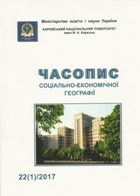Development modelling of Ukrainian economy development in complacence with interaction to regional and global integration associations
Abstract
The result of research is composition multidimensional mental (cognitive) mode of development social and territorial complex ofUkraine. Such approach for modelling gives possibilities of analysis model components and timing of development every component. There were defined 7 sub-models covering different areas of development human-geographic territorial complex.
Among functional actions in the model implementation defined priority actions deal with the prior development of national market and increase of its consumption for development or revitalization different broaches of economy as competitive brunches for the sustainable export development and increasing productive cooperation in the framework of regional and branches integration processes (Sub-model 1); strategy for the development cooperation in diversification energy supply for Ukraine (Sub-model 2); strategy for the development trade relations with countries of symmetric and a-symmetric bilateral l trade and economic relations (Sub-model 3(; strategy for supply balanced development of different parts of Ukraine in complacence with natural, social and economic potential territories for the development export-oriented brunches of industry (Sub-model 4); system of actions and decisions for the development integration processes with regional integration associations and choice of the forms of interactions due to strategic Ukrainian interests (Sub-model 5); interaction and coordination with global integration associations to supply national security and national interests on the global level (Sub-model 6); strategy of the development of education and innovations to supply sustainable (balanced) development (Sub-model 7).
Dynamic interaction between sub-models is the core of general cognitive model of country development for the purpose country transformation from object to the subject of world economic order to the supply the increase role ofUkrainein regional and global integration associations.
Downloads
References
2. Polyakov, O.U., Omarov, Sh.A. (2012). Modelirovanie sotsialno-economicheskogo rasvitiya regionov strany na osnove impulsnych protzessov [Modelling of social and economic development country regions based on impulse processes]. Problemy economiky, 46, 228 -331.
3. Prokhorova, V.V. (2011) Kogninitivnoe modelirovanie ustoychivogo ekonomicheskogo razvitiya predpriyatiy. [Cognitive modelling of sustainable economic development of legal entities]. Economics and managment. Moskva, 24-29.
4. Taranenko, I.V. (2015). Geoprostorovi modeli innovatziynoi konkerentospromozhnosti krain. [Geospatial models innovation competitiveness of countries]. European Vector of Economic Development, 1(10), 168-183.
5. Porter, M.E. (1990). Competitive advantages of nations. New York: Free Press, 896.
Copyright (c) 2017 Ярослав Олійник, Анатолій Бобровицький

This work is licensed under a Creative Commons Attribution 4.0 International License.




